A social tendency in which people find value in the possession of material things is known as "material consumption." Japan encapsulated this during its period of high economic growth. Eventually, Japan became prosperous, overflowing with material things. When this happened, the consumption trend shifted to "experiential consumption," which finds value in the experience obtained in purchasing products or services. Borrowing the words of Professor Takashi Maeno of Keio University, Japan's foremost authority in happiness research, two factors that give people a sense of wellbeing are material wealth and spiritual wealth, and people who feel satisfaction or happiness from spiritual wealth have come to make up a greater percentage of the population.
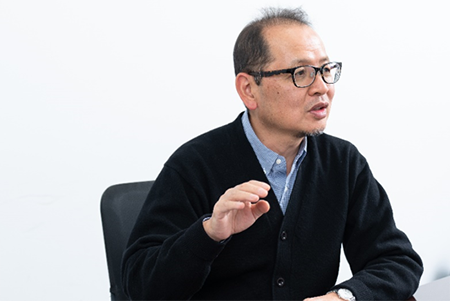
Professor Takashi Maeno, Graduate School of System Design
and Management, Keio University
Photograph: Daisuke Yoshinari
According to a research analysis done by Professor Maeno, factors influencing human happiness can be divided into four parts: "let's try it", "thank you", "it will turn out all right", and "be yourself". He says that modern-day Japanese people feel happiness particularly intensely when able to satisfy all four of these factors while maintaining mutual relationships with other people, instead of being isolated from each other.
So, how can people be happy? Clues are found in happy cities that produce spiritual wealth.
This article explores the secret to producing happy cities like this. Exchanges between diverse human resources are currently garnering attention. What kind of environment and space can deepen this to generate innovation?
(For details on the four factors of happiness, read Hitachi Review "Toward a Fully Harmonious Society that Puts Wellbeing First" [November 2019].)
As mentioned above, Professor Maeno says recent years have seen a greater number of people getting satisfaction and happiness through spiritual wealth. One function required in cities is to prepare "spaces" where people can carry out activities with an independent mindset and share their ideas and concepts freely. Spaces like these are more likely to produce innovation.
Innovation refers to the mingling and mixing of existing technologies and knowledge to create new societal and economic values, accompanied by the widely encompassing expansion of the produced effects. Not only businesses, but, in the broader sense, society as a whole are in need of this kind of innovation. The modern era is changing fast, and large numbers of factors are tangling up in complex ways, turning into challenges. What is needed now is "open innovation" by which clues to solutions and revolutionary effects can come out of interactions between people instead of attempting to find solutions solely with one's own technologies.
Open innovation in Japan, however, has fallen far behind the rest of the world, and this is precisely the reason why spaces that promote an open innovation mindset and collaboration aimed at realizing such are being recognized as important.
This is not restricted to business activities. This can also be said of cities and towns throughout the world where various challenges are piling up. In Japan, as the paradigm shift toward Society 5.0, which promotes the realization of a super-smart society, goes forward, it has become important to think and work on a large scale toward solutions to essential challenges instead of having municipalities and infrastructure companies deal with urban challenges individually.
Not only municipalities and companies but also residents themselves may be involved in the various challenges faced by cities, with everyone taking these challenges on as their own and concentrating their various types of knowledge while sharing a vision for a future society. The creation of spaces that produce the driving force for such open innovation as this is showing results in Japan.
One example of this is Kyōsō-no-Mori, a research and development site nestled in the lush greenery of Kokubunji City, located in Tokyo. Kyoso-no-Mori was launched from Hitachi’s Central Research Laboratory in April 2019. Its mission is to accelerate the creation of new innovation to realize Hitachi's goal of a prosperous and sustainable human-centric society that provides a high quality of life (QoL). It is becoming an environment where new ideas are born, departing from the traditional one-on-one co-creation style to a place where Hitachi researchers and designers can engage in open collaborative creation with global customers and partners while sharing with them a vision for solutions to societal challenges.
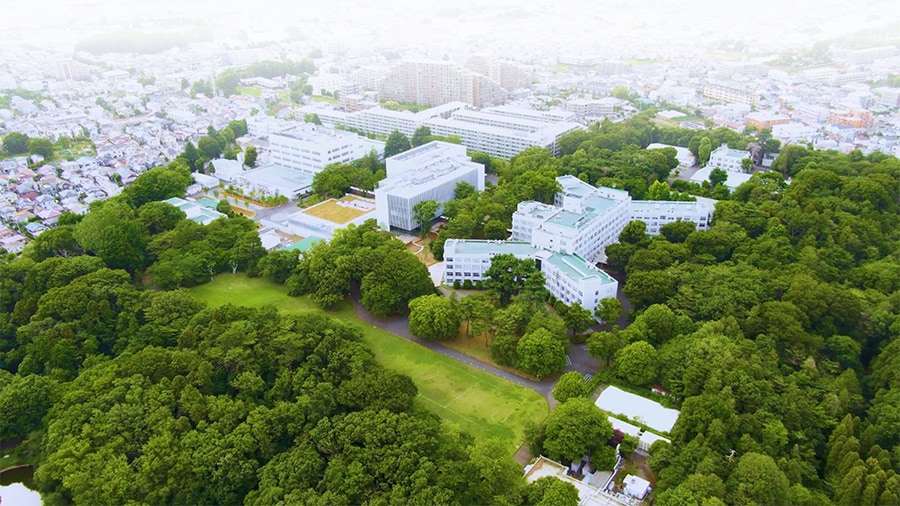
Photograph: Kyōsō-no-Mori located within the Central Research Laboratory, Kokubunji City (aerial view)
To drive innovation however, it is not enough to just create a space where people will gather. A key feature of Kyōsō-no-Mori is embedded within. It is a mechanism that sublimates human interaction into innovation. Kyōsō-no-Mori not only provides a physical space, but it also places emphasis on mechanisms to manage the goal of pursuing common good such as resolving societal challenges, and the direction innovation should take.
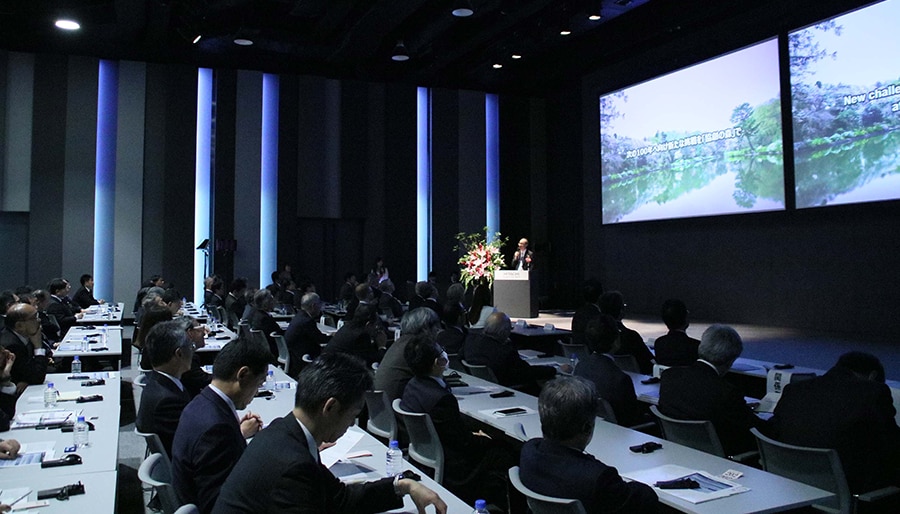
Photograph: Baba Memorial Hall
Future societal challenges are raised at the Baba Memorial Hall, an international conference venue. Ideas or solutions are then conceived, and then leveraging digital technology, agilely prototyped and repeatedly verified in quick cycles. To enable such end-to-end flow on one site, the different functions were integrated in the form of the “NEXPERIENCE Space” which provides a methodology to generate new business concepts, and the “Project Space” which provides access to the Lumada IoT platform equipped with cutting-edge digital technology. These are examples of spaces created to increase success of business proposals and time-to-market of collaborative creation projects with external partners.
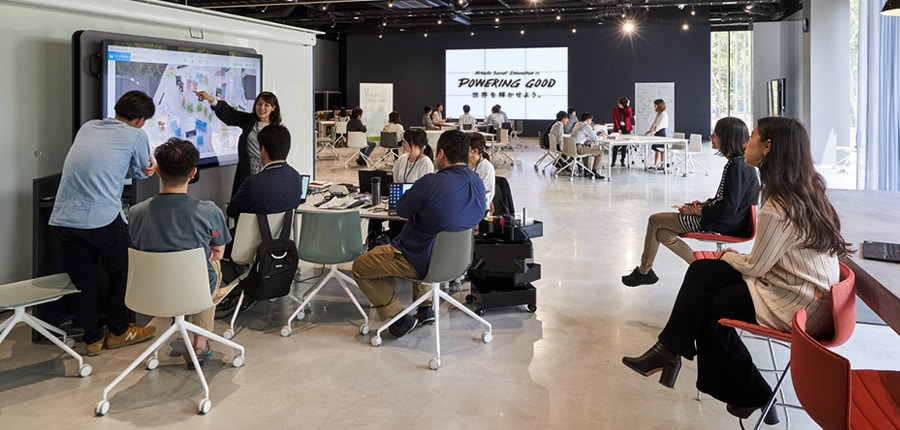
Photograph: Workspace in Kyōsō-no-Mori
Furthermore, this process is not limited to within Kyōsō-no-Mori but is also being extended to activities within the local community of Kokubunji City. Pre-empting future challenges that may be faced by the local community, residents themselves are promoting initiatives to create a brighter future, creating a framework where designers, engineers and researchers can also actively contribute to the community.
(For details, see Kyōsō-no-Mori.)
Creating spaces for a happy city is not limited to residential areas, but also extends to work districts. In September 2019, Mitsui Fudosan, a real estate company that deals in office buildings, opened CUIMOTTE in the Nakanoshima Mitsui Building in the city of Osaka, as an office space that embodies its "An office of the future" concept.
CUIMOTTE was opened in conjunction with the large-scale remodeling of the 17-year-old office building. Encouraging connections between the office workers employed by the tenants, this combination dining and working area aspires to act as an open space where various ideas and innovation can be generated. A cafe & bar area for all-day use was provided in the cafeteria space - which was originally envisaged for lunch - as a place for the natural outgrowth of human interaction. In addition, a library, Wi-Fi, power stations, monitors, and conference rooms provide the final finishes as a workspace.
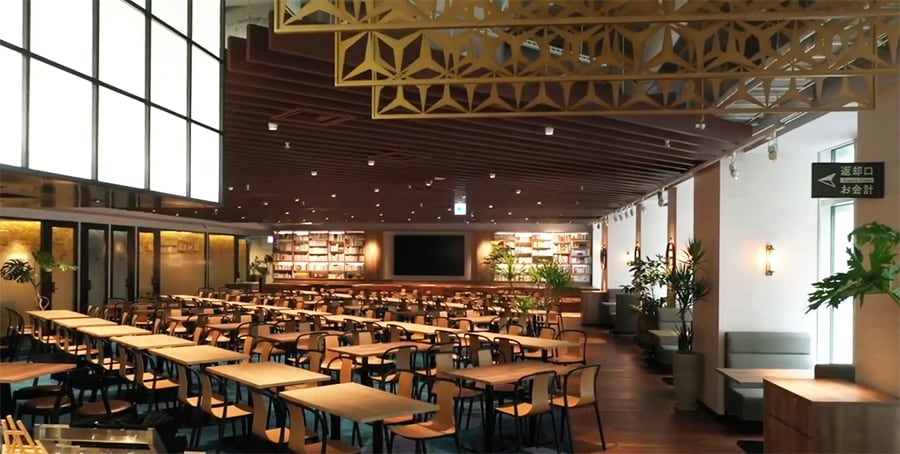
Photograph: CUIMOTTE, within the Nakanoshima Mitsui Building
Behind-the-scenes support for the birth of this unique cafeteria for office tenants comes from Hitachi’s original Experience Oriented Approach (Ex Approach) to co-creation combining design and digital technology. Focused on "experience values" that people feel, such as the delight, excitement, and joy they get out of new businesses and services, Ex Approach is a method that employs surveys and workshops for Hitachi and its customers to carry out as collaborative creation for new businesses and services. The starting point of this two-year project was using Design Thinking to come up with "An office of the future." This was followed by delving, from a human standpoint, into how people think and what kinds of delight they feel.
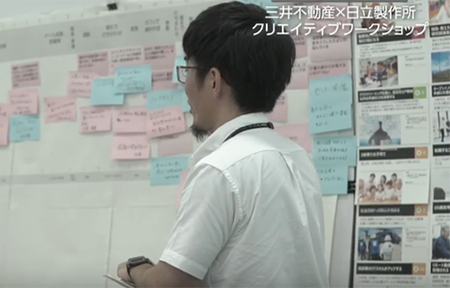
Creative workshop by Mitsui Fudosan & Hitachi, Ltd.
Workshops for collaborative creation - carried out with the participation of Mitsui Fudosan, Hitachi designers and engineers, and occasionally tenants and office workers - engendered in the people in charge and the users an independent mindset that enabled them to think proactively. This brought to light Mitsui Fudosan's idea of not just creating a space but also capturing changing needs, an idea which was then realized using Hitachi digital technologies. This became the kind of project whose aim was to take on the challenge of bringing about a breakthrough by combining knowledge and information from the field (Mitsui Fudosan) and from technology (Hitachi, Ltd.).
This initiative, aimed to create a next-generation office, continues even after the reopening of the building. To become an office building that continuously captures changing needs, Hitachi's image analysis technology was introduced. This technology is envisioned for application in analyzing data facility and function data in order to understand reasons for lower-than-predicted usage rates and for using this information to revise the target facility or function. Capturing needs by getting detailed behavior and information data on people and applying the results to new services signals the beginning of a new use of data from office buildings.
The case studies introduced here are example of space creation that leads to individual’s happiness, and eventually to that of the entire city, regions, countries, and finally the world. Although each of the initiatives may only be one of many examples of such initiatives, without them, efforts toward solving larger societal challenges may not be realizable. Not limiting itself to corporate customers, Hitachi will hybridize its assets with a wider range of knowledge and sensibilities that is has gained from startup companies, community residents, and the academia in order to build a global innovation ecosystem that creates substantial value and scales up the realization of happy cities.